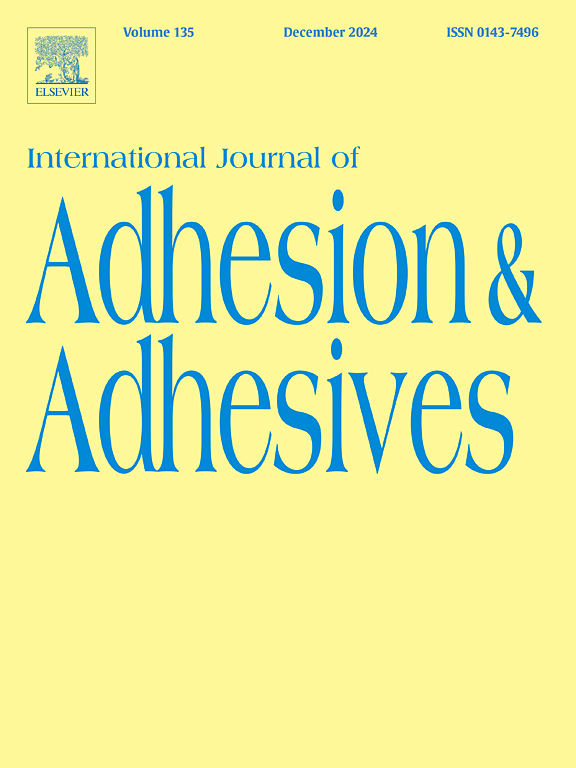Preparation and characterization of UV-Curable phosphate ester-containing acrylate resin adhesive for dental zirconia restorations
IF 3.2
3区 材料科学
Q2 ENGINEERING, CHEMICAL
International Journal of Adhesion and Adhesives
Pub Date : 2024-11-02
DOI:10.1016/j.ijadhadh.2024.103874
引用次数: 0
Abstract
Fumed silica was utilized as a filler, methacryloyloxydecyl dihydrogen phosphate (MDP) served as a reactive monomer, and acrylate acted as a resin monomer to develop zirconia adhesives for dental acrylate resins containing phosphate esters. A uniform design, orthogonal tests, and single-variable experiments were conducted to vary the composition of each component. The effects of different composition ratios on the mechanical properties, hydrophilicity, flowability, and volumetric shrinkage of dental resin adhesives were studied in detail. The resin matrix composition included 43.6 wt% Bis-GMA, 28.2 wt% triethylene glycol dimethacrylate (TEGDMA), and 28.2 wt% hydroxyethyl methacrylate (HEMA). The photocurable system composition consisted of 4 % camphorquinone (CQ), 2.4 % ethyl 4-dimethylaminobenzoate (EDB), 3.2 % dimethylaminoethyl methacrylate (DMAEMA), and 1 % butylated hydroxytoluene (BHT). The adhesive monomer was 12 % MDP, and the filler system comprised 2 % R972 and 3 % OX50. The light curing time was set at 60 s. The adhesive exhibited optimal performance with a bonding strength of 35.9 MPa and a volumetric shrinkage of 13.3 %. According to this study, the proposed zirconia adhesive featuring a phosphate-containing acrylic ester group is a potential light-curing dental resin adhesive with a straightforward synthesis procedure, minimal volumetric shrinkage, good bonding strength, and an appropriate photocuring time.
用于牙科氧化锆修复体的紫外线固化含磷酸酯丙烯酸酯树脂粘合剂的制备和特性分析
利用气相法二氧化硅作为填料,甲基丙烯酰氧癸基磷酸二氢酯(MDP)作为活性单体,丙烯酸酯作为树脂单体,开发出含有磷酸酯的牙科丙烯酸酯树脂氧化锆粘合剂。通过统一设计、正交试验和单变量实验来改变各组分的组成。详细研究了不同成分比例对牙科树脂粘合剂的机械性能、亲水性、流动性和体积收缩率的影响。树脂基质成分包括 43.6 wt% 的双-GMA、28.2 wt% 的三乙二醇二甲基丙烯酸酯 (TEGDMA) 和 28.2 wt% 的甲基丙烯酸羟乙酯 (HEMA)。光固化系统成分包括 4 % 的樟脑醌 (CQ)、2.4 % 的对二甲氨基苯甲酸乙酯 (EDB)、3.2 % 的甲基丙烯酸二甲胺基乙酯 (DMAEMA) 和 1 % 的丁基羟基甲苯 (BHT)。粘合剂单体为 12 % MDP,填料系统包括 2 % R972 和 3 % OX50。光固化时间设定为 60 秒。粘合剂表现出最佳性能,粘合强度为 35.9 兆帕,体积收缩率为 13.3%。根据这项研究,拟议的氧化锆粘合剂具有含磷酸丙烯酸酯基团,是一种潜在的光固化牙科树脂粘合剂,其合成过程简单,体积收缩率最小,粘合强度高,光固化时间合适。
本文章由计算机程序翻译,如有差异,请以英文原文为准。
求助全文
约1分钟内获得全文
求助全文
来源期刊

International Journal of Adhesion and Adhesives
工程技术-材料科学:综合
CiteScore
6.90
自引率
8.80%
发文量
200
审稿时长
8.3 months
期刊介绍:
The International Journal of Adhesion and Adhesives draws together the many aspects of the science and technology of adhesive materials, from fundamental research and development work to industrial applications. Subject areas covered include: interfacial interactions, surface chemistry, methods of testing, accumulation of test data on physical and mechanical properties, environmental effects, new adhesive materials, sealants, design of bonded joints, and manufacturing technology.
 求助内容:
求助内容: 应助结果提醒方式:
应助结果提醒方式:


